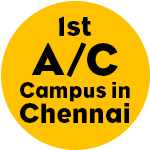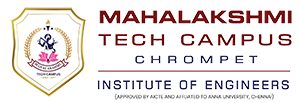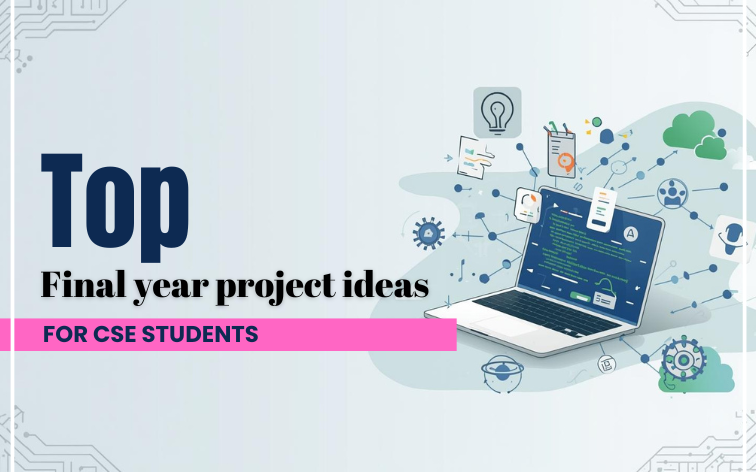
Computer science engineering students might gain knowledge through theoretical studies, but it must be put into practice to get expertise. It can be done through engaging in CSE final year projects. It allows you to get your hands on many technologies, acquire industrial knowledge, and span into different domains like artificial intelligence, data security, machine learning, and cybersecurity. Some of the best final year projects for CSE students are AI-personal assistant, sentiment analysis, fitness tracker application, and language learning app. You can also combine your creativity to create an altogether new technology and application. In this article, we have enlisted 20 best final year project ideas for CSE students with brief descriptions and instructions.
Our Mahalakshmi Tech Campus teaching faculties encourage B.E Computer science engineering students to develop projects that improve the students skills and contribute to the society in some way. By doing this, our students will not only attain technical brilliance but also feel satisfied.
20 Best Final year project ideas for CSE Students
Below, we have listed the 20 best final year project ideas for CSE students with enough information to help the students to decide which CSE project they can devote their efforts to. Choose the project that interests you and pushes your expertise to advanced level:
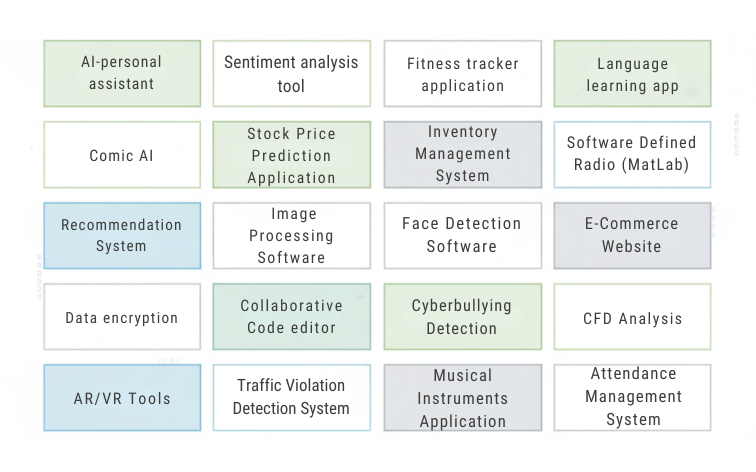
1. AI-personal assistant
AI-personal assistants can understand natural language commands and perform tasks like setting reminders, answering questions, managing schedules, and controlling smart devices. It automates daily tasks, provides information on demand, manages calendars, sends notifications, and integrates with various applications to streamline personal productivity. Python or JavaScript, natural language processing (NLP) libraries like spaCy or NLTK, speech recognition APIs (Google Speech API, Whisper), machine learning frameworks (TensorFlow, PyTorch), and API integration skills. Students can expertise in designing conversational interfaces and understand user experience principles for voice-based applications. This technology is more accessible to people with disabilities, improves productivity for busy professionals, and helps elderly individuals manage their daily routines independently.
2. Sentiment analysis tool
Sentiment analysis tool analyzes text data to determine the emotional tone and sentiment (positive, negative, or neutral) expressed in reviews, social media posts, or customer feedback. It processes large volumes of text, identifies sentiment patterns, generates sentiment scores, and visualizes results through dashboards to help businesses understand public opinion. Students develop expertise in text mining, machine learning classification, feature engineering, and data visualization. They learn to handle real-world unstructured data and build practical AI solutions. This tool enables businesses to understand customer satisfaction, helps mental health professionals identify at-risk individuals through social media monitoring, and assists in detecting fake news or harmful content online.
3. Fitness tracker application
Fitness tracker application monitors physical activities, tracks workouts, records nutrition intake, and provides personalized fitness recommendations. It logs exercises, counts steps and calories, monitors heart rate, sets fitness goals, provides workout plans, and displays progress through charts and statistics. Students can learn mobile app development, sensor integration, data persistence, user interface design, and health informatics. It promotes healthier lifestyles, reduces obesity and related health issues, makes fitness accessible to everyone regardless of economic status, and helps people with chronic conditions manage their health better.
4. Language learning app
The language learning app teaches foreign languages through lessons, quizzes, games, and conversational practice with AI-powered chatbots. It provides structured language courses, offers pronunciation feedback, tests vocabulary and grammar, tracks learning progress, and adapts difficulty levels based on user performance. Students can develop skills in educational technology, adaptive learning systems, speech processing, game design, and creating engaging user experiences. They learn to build applications that respond to individual learning patterns. It breaks down language barriers, promotes cultural understanding and global communication, provides affordable education to underserved communities, and enhances employment opportunities for learners worldwide.
5. Comic AI
Comic AI generates comic strips or graphic novel content by creating illustrations, dialogue, and storylines based on user prompts or themes. It uses generative AI models to create comic characters, panels, scenes, and narratives. Users can input story ideas and the system generates visual comic content with appropriate dialogue and artistic styles. Generative AI models (Stable Diffusion, DALL-E), Python, image processing libraries (OpenCV, PIL), natural language generation, prompt engineering, and knowledge of comic art principles and panel layouts. Students explore cutting-edge generative AI technology, learn about creative applications of machine learning, understand artistic composition, and develop skills in prompt engineering and creative AI tool development. It helps the storytellers or creative artists to simplify their comics creation process.
6. Stock Price Prediction Application
Stock price prediction tool uses historical stock market data and machine learning algorithms to forecast future stock prices and market trends. It collects financial data from market APIs, processes time-series information, applies predictive models (LSTM, ARIMA), generates price forecasts, and visualizes trends through interactive charts and risk assessments. Students gain knowledge in financial technology, time-series forecasting, deep learning, data analysis, and understanding of market dynamics. They learn to work with real-world financial datasets and evaluate model accuracy. It helps individual investors in making informed decisions, democratizes financial analysis tools previously available only to institutions, promotes financial literacy, and helps people plan for retirement and long-term investments.
7. Inventory Management System
Inventory management system tracks product stock levels, manages warehouse operations, monitors supplier information, and automates reordering processes for businesses. It records inventory movements, generates reports on stock levels, sends alerts for low inventory, manages multiple warehouse locations, tracks product expiration dates, and integrates with sales and procurement systems. Students learn enterprise software development, database design and optimization, business logic implementation, system integration, and creating scalable solutions for real business problems. It reduces waste through better inventory tracking, helps small businesses compete more effectively, prevents stockouts of essential goods, improves supply chain efficiency, and contributes to more sustainable consumption patterns.
8. Software Defined Radio (MatLab)
Software defined radio using MATLAB where components traditionally built in hardware (mixers, filters, modulators) are instead created through digital signal processing code. It receives, transmits, and processes radio signals using algorithms rather than fixed hardware. Users can experiment with different modulation schemes, analyze signal characteristics, and implement communication protocols entirely in software.Students gain a deep understanding of wireless communication systems, signal processing, frequency analysis, and RF engineering. This application advances research in wireless communications, enables rapid prototyping of new communication standards, supports emergency communication systems, helps in spectrum monitoring for regulatory purposes, and makes radio technology education more accessible.
9. Recommendation System
Recommendation system suggests products, content, or services to users based on their preferences, behavior patterns, and similarities to other users. It analyzes user interactions, purchase history, ratings, and browsing patterns to predict what items users might be interested in. It uses collaborative filtering, content-based filtering, or hybrid approaches to generate personalized recommendations. Students master machine learning algorithms, data mining techniques, big data processing, and user behavior analysis. This recommendation system application improves user experience on platforms, helps consumers discover relevant products and content, supports small businesses by connecting them with interested customers, and personalizes education by recommending appropriate learning materials.
10. Image Processing Software
Image processing software manipulates, enhances, analyzes, and transforms digital images through various computational techniques and filters. It performs operations like filtering, edge detection, color correction, object segmentation, image restoration, compression, format conversion, and feature extraction for various image analysis tasks. Students develop strong foundations in computer vision, algorithm implementation, mathematical operations on images, and optimization techniques. It supports medical imaging for better disease diagnosis, enhances satellite imagery for environmental monitoring, aids law enforcement in forensic analysis, improves accessibility through image enhancement for visually impaired individuals.
Learn more: Mini Project Ideas for CSE Students
11. Face Detection Software
Face detection software automatically identifies and locates human faces in digital images or video streams using machine learning algorithms. It scans images or video frames, detects facial features using trained models, marks face locations with bounding boxes, can recognize facial landmarks, and potentially identify individuals through face recognition algorithms. Students can get used to computer vision, neural networks, real-time processing, model training and evaluation, and ethical considerations around biometric technology. This final year project for CSE enhances security systems, helps find missing persons, enables touchless authentication for accessibility, assists in organizing personal photo collections, and supports medical research in genetic disorders affecting facial features.
12. E-Commerce Website
E-commerce websites enable businesses to sell products or services over the internet, complete with product catalogs, shopping carts, payment processing, and order management. It displays products with descriptions and images, manages user accounts, processes shopping carts and checkout, handles secure payment transactions, tracks orders and shipping, and provides customer reviews and support features. Students learn complete web application development, database design, security implementation, payment processing, user authentication, responsive design, and deployment practices. This major project for CSE final year empowers small businesses and entrepreneurs to reach global markets, creates employment opportunities, provides convenient shopping access to rural and remote areas, and enables economic growth through digital commerce.
13. Data encryption
Data encryption tool converts readable data (plaintext) into encoded format (ciphertext) using cryptographic algorithms to protect sensitive information from unauthorized access. It encrypts files, messages, or data streams using algorithms like AES, RSA, or hybrid methods, manages encryption keys, decrypts data for authorized users, and ensures data integrity through hashing and digital signatures. Students can learn cryptography fundamentals, learn to implement security measures that are crucial in modern software development. This BTech final year project for CSE protects personal privacy and sensitive information, secures financial transactions and medical records, enables secure communication for journalists and activists in oppressive regimes, and builds trust in digital systems.
14. Collaborative Code editor
A real-time, multi-user code editing platform that allows multiple developers to write, edit, and review code simultaneously in a shared workspace, similar to Google Docs but for programming. It provides synchronized code editing across multiple users, shows cursor positions and selections of collaborators, offers syntax highlighting, supports multiple programming languages, includes integrated chat, and enables real-time collaboration on software projects. WebSocket technology for real-time communication, operational transformation or CRDT algorithms, web development (React, Vue.js), code editor libraries (Monaco Editor, CodeMirror), backend (Node.js, Socket.io), and conflict resolution mechanisms. Students learn real-time application development, distributed systems, conflict resolution algorithms, websocket programming, and building collaborative tools. They understand the complexity of synchronization in distributed environments. Enables remote work and distributed teams, facilitates coding education through pair programming, helps developers across different time zones collaborate efficiently, and makes programming education more accessible through shared learning environments.
15. Cyberbullying Detection
An AI-powered monitoring system that automatically identifies and flags instances of cyberbullying, harassment, or harmful content in digital communications, social media, or online platforms. It analyzes text messages, comments, and posts using natural language processing and machine learning to detect offensive language, threats, harassment patterns, and harmful content. It alerts moderators or parents and can automatically filter or block harmful messages. Python, natural language processing libraries, machine learning classification algorithms, sentiment analysis, text preprocessing, deep learning (LSTM, BERT), API development, and understanding of content moderation policies. Students develop skills in NLP, ethical AI development, classification models, and handling sensitive data.This technology can protect children and vulnerable individuals online, reduces mental health impacts of online harassment, creates safer online communities, supports parents and educators in monitoring digital interactions, and helps social media platforms maintain healthier environments.
Also read: Top Cybersecurity Projects for Students
16. CFD Analysis
Computational Fluid Dynamics software that uses numerical methods and algorithms to analyze and simulate fluid flow, heat transfer, and related phenomena in engineering and scientific applications. It creates computational models of fluid systems, solves complex fluid dynamics equations (Navier-Stokes), simulates flow patterns around objects, analyzes heat transfer and turbulence, and visualizes results through pressure maps, velocity fields, and streamlines. Students gain expertise in computational engineering, numerical simulation, fluid dynamics, high-performance computing, and scientific visualization. CFD Analysis optimizes aircraft and vehicle designs for fuel efficiency, improves medical devices like artificial hearts, enhances building ventilation systems for better air quality, assists in weather prediction and climate modeling, and reduces need for expensive physical prototypes.
17. AR/VR Tools
Augmented Reality and Virtual Reality development tools and applications that create immersive digital experiences by overlaying virtual content on the real world (AR) or creating completely virtual environments (VR). AR tools add digital information, 3D models, or interactive elements to real-world views through smartphones or AR glasses. VR tools create fully immersive 3D environments for training, entertainment, or simulation purposes using headsets and controllers. Unity or Unreal Engine, C# or C++ programming, 3D modeling (Blender, Maya), AR frameworks (ARCore, ARKit, Vuforia), VR SDKs (Oculus SDK, SteamVR), spatial computing, 3D mathematics, and UX design for immersive experiences. Students learn 3D development, game engine programming, spatial computing, human-computer interaction, and emerging technology platforms. They gain skills in one of the fastest-growing areas of technology. Revolutionizes education through immersive learning experiences, enables remote collaboration and virtual meetings, provides therapeutic applications for phobias and PTSD, assists in medical training and surgical planning, and makes experiences accessible to people who cannot physically travel.
18. Traffic Violation Detection System
Traffic violation detection system monitors traffic through cameras and detects violations such as speeding, running red lights, illegal parking, wrong-way driving, and not wearing helmets or seatbelts. It processes video feeds from traffic cameras, detects vehicles and their movements using object detection algorithms, identifies license plates through OCR, recognizes traffic violations based on predefined rules, and generates automated reports or tickets. Students develop advanced computer vision skills, real-time processing capabilities, deep learning model deployment, and understanding of intelligent transportation systems. It improves road safety by deterring traffic violations, reduces accidents and fatalities, enables efficient traffic management, reduces need for manual traffic police deployment, generates data for urban planning, and creates safer communities through automated enforcement.
19. Musical Instruments Application
Musical instruments applications simulate real musical instruments or create entirely new digital instruments, allowing users to compose, play, and produce music using computers or mobile devices. It generates musical sounds through synthesis or sampling, responds to MIDI input or touchscreen interactions, provides virtual keyboards, drum pads, or guitar interfaces, includes effects processing, and enables multi-track recording and composition. Students learn audio programming, signal processing, real-time systems, music technology, and creating responsive interactive applications. This final year project for CSE makes music creation accessible to people who cannot afford physical instruments, enables people with physical disabilities to create music, provides therapeutic tools for music therapy, preserves traditional instruments digitally, and democratizes music education globally.
20. Attendance Management System
Attendance management system tracks and manages attendance records for educational institutions or workplaces using various methods like biometric scanning, RFID, face recognition, or mobile check-ins. It records attendance data automatically, maintains historical attendance records, generates reports and analytics, sends notifications for absences, integrates with existing management systems, calculates attendance percentages, and provides dashboard views for administrators. Students learn full-stack development, database design, system integration, hardware-software interfacing, and creating practical enterprise solutions. This system can eliminate time-consuming manual attendance taking, reduces proxy attendance and fraud, provides accurate data for payroll and academic evaluation, helps identify attendance patterns that may indicate problems, saves administrative time, and maintains transparent records for accountability.
Top Sites to Develop Final Year Projects for CSE Students
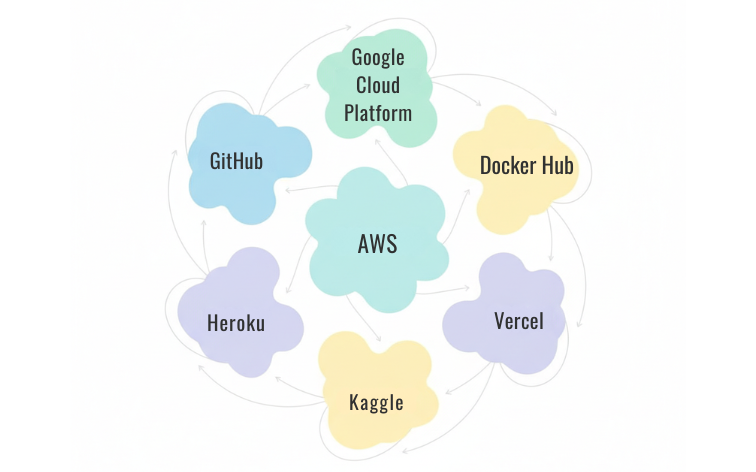
Below, we have listed some top sites to develop final year projects for CSE students:
GitHub
GitHub is the world’s largest code hosting and version control platform used by over 100 million developers worldwide. It provides a collaborative environment where you can store your project code, track changes, manage versions, and work with team members seamlessly. The platform uses Git for version control, allowing you to maintain a complete history of your project development. You can create public repositories to showcase your work or private repositories for confidential projects.
Google Cloud Platform (GCP)
Google Cloud Platform is a comprehensive suite of cloud computing services that runs on the same infrastructure Google uses for its own products like Search and YouTube. It offers powerful tools for hosting applications, storing data, running machine learning models, and analyzing big data. GCP is particularly strong for AI/ML projects with services like Vertex AI, pre-trained APIs for vision, language, and speech processing, and AutoML for custom model training. The platform includes Compute Engine for virtual machines, Cloud Storage for file storage, Cloud SQL for managed databases, Firebase for mobile app backends, and BigQuery for data analytics.
AWS (Amazon Web Services)
Amazon Web Services is the most widely adopted cloud platform in the industry, offering over 200 fully-featured services from data centers globally. AWS provides the infrastructure and tools needed to build virtually any type of application, from simple web apps to complex machine learning systems. Key services for student projects include EC2 (virtual servers), S3 (scalable storage), RDS (managed relational databases), Lambda (serverless computing), and SageMaker (machine learning). Through AWS Educate and AWS Academy, students get free credits and access to extensive learning resources without needing a credit card. AWS experience is highly valued by employers as it’s used by major companies worldwide, making it an excellent addition to your technical skill set.
Heroku
Heroku is a cloud platform-as-a-service (PaaS) that enables developers to build, run, and operate applications entirely in the cloud without worrying about infrastructure management. It’s particularly beginner-friendly because it abstracts away server configuration and focuses on application deployment. Heroku supports multiple programming languages including Python, Node.js, Ruby, Java, PHP, and Go, making it versatile for various project types. The platform excels at deploying web applications, RESTful APIs, data processing applications, and chatbots. Heroku’s free tier (though limited) allows you to host multiple projects simultaneously, with features like automatic HTTPS, integrated logging, and easy database provisioning through add-ons like Heroku Postgres.
Kaggle
Kaggle is the world’s largest data science and machine learning community, owned by Google, where over 10 million data scientists and ML engineers collaborate, compete, and learn. It’s an invaluable resource for CSE students working on AI, machine learning, data analytics, or predictive modeling projects. Kaggle provides free access to thousands of real-world datasets across diverse domains (healthcare, finance, climate, social media), cloud-based Jupyter notebooks with pre-installed ML libraries, free GPU and TPU computing resources for training models, and competitions where you can test your skills against others. The platform’s community publishes millions of notebooks with code examples, tutorials, and complete project implementations that you can learn from and adapt.
Vercel
Vercel is a cutting-edge cloud platform specifically optimized for frontend frameworks and static site generation, created by the developers of Next.js. It provides the fastest way to deploy modern web applications with automatic optimizations, global content delivery, and zero-configuration deployment. Vercel excels at hosting React, Next.js, Vue, Angular, Svelte, and static HTML/CSS/JavaScript projects with features like automatic HTTPS, instant rollbacks, preview deployments for every Git push, edge functions for serverless computing, and built-in analytics. The free tier is extremely generous for student projects, offering unlimited personal projects, 100GB bandwidth per month, and automatic SSL certificates.
Docker Hub
Docker Hub is the world’s largest repository for container images, serving as the central hub for containerized application distribution and deployment. Docker enables you to package your application along with all its dependencies, libraries, and configurations into standardized containers that run consistently across any environment—from your laptop to production servers. This “write once, run anywhere” approach eliminates the common problem of “it works on my machine but not on yours.” Docker Hub hosts millions of pre-built images for databases (MySQL, MongoDB, PostgreSQL), programming environments (Python, Node.js, Java), web servers (Nginx, Apache), and complete application stacks that you can use as building blocks for your project.
How to Produce Innovative Computer Science Projects?
Below, we have detailed five ways to produce innovative computer science projects:
1. Identify Real-World Problems in Your Community
Observe challenges in your surroundings—college campus, local businesses, healthcare facilities, or daily routines. Talk to potential users to understand their pain points and inefficiencies that technology could solve, ensuring your project addresses genuine needs rather than imaginary problems.
2. Combine Multiple Technologies or Domains Creatively
Merge different fields like AI with IoT, blockchain with healthcare, or computer vision with agriculture. Innovation often happens at the intersection of technologies, creating unique solutions that stand out from conventional single-technology approaches.
3. Start with Minimum Viable Product (MVP) and Iterate Based on Feedback
Build a basic working version with core functionality first, test it with real users, gather feedback, and improve iteratively. This agile approach produces better results than attempting to create a perfect system from day one.
4. Research Existing Solutions and Find Their Gaps
Study commercial products, open-source projects, and academic papers to identify limitations in current solutions. Focus on addressing specific gaps like affordability, accessibility, regional language support, or features missing in existing applications.
5. Use Open Source Libraries and Focus on Unique Value Addition
Use established frameworks and libraries for common functionalities, then concentrate your efforts on building innovative core features. Smart use of existing tools allows you to create sophisticated projects while focusing on what makes your solution truly unique.
Conclusion
Final year projects in Computer Science Engineering are more than academic requirements—they are gateways to innovation, practical skill-building, and career readiness. By engaging in projects across domains such as AI, cybersecurity, data science, and cloud computing, students can bridge the gap between theory and practice. These projects not only sharpen technical expertise but also foster creativity, problem-solving, and societal impact. Choosing the right project aligned with your interests and industry trends can greatly enhance your portfolio, making you stand out to future employers and paving the way for advanced learning opportunities.

